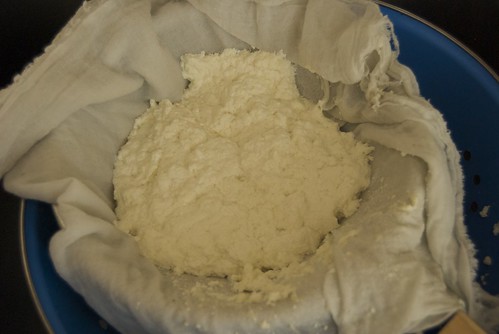
Have you ever made cheese? It is one of those delicious foods that for many comes from a store or maybe from a farm that carefully transforms milk of its cows, sheep or goats. I did a brief stint as a an apprentice cheese maker at a small creamery in Maine. We wore rubber boots, hairnets, and rubber aprons and worked in an incredibly steamy and very well sanitized environment. The milk was pumped into a vat that held a few hundred gallons and with the help of enzymes, heat, and lots and lots of stirring and mixing it became cheese. It also took pressing, washing, aging, cutting and packaging to get it ready for eating.
My experience at the creamery made me fairly certain that I will never be an artisan or commercial cheese maker, but I am still interested in making cheese on a small scale in my home. I do dream of someday having a couple of goats and using their milk to make cheese and feed my family. So far my home cheese making has been limited to simple soft cheeses but this is a good place to start.

Ricotta cheese is even easier to make than yogurt. Traditionally it is made with the whey left over from making a hard cheese. The whey is fermented and then the remaining proteins fuse together to make the curd. I haven't tried making traditional ricotta yet, but I have made simple ricotta from milk many times. The recipe doesn't require any fancy tools or ingredients and you can have a fresh, soft cheese in very little time.
Ricotta goes well with pasta, on pizza, in pancakes, in cookies and cheesecakes, with honey and fruit. There are so many ways to use and enjoy homemade cheese. I most often make ricotta for my homemade lasagna. I don't make lasagna frequently, but when I do, I like to make it almost entirely from scratch. Ricotta, pasta and sauce are three elements that can be simply made in your kitchen and used in endless combinations and dishes. So, I thought we could make a lasagna together. Today I'm sharing the recipe for ricotta, I'll post the pasta and sauce recipes next week, and then we'll put it all together into a warm and hearty homemade dish. If you have any suggestions for your favorite lasagna ingredients or techniques along the way, please share them in the comments.

Whole Milk Ricotta
One of the best resources I have found for home cheese making is New England Cheesemaking Supply I bought a starter kit from them a while back which is the basis for this recipe. The kit includes citric acid powder which can be used as the acid that forms the ricotta curds. You don't need citric acid, though, white vinegar works just fine. If you don't have cheese cloth, you could use a clean dishtowel --one that will let the whey through but not the curds.
1 gallon whole milk (its great if you can get local or organic milk)
3 tablespoons white vinegar or 1 teaspoon citric acid dissolved in 1/4 cup cool water
1 teaspoon of salt (you don't have to add salt, however it does give the cheese more flavor)
Pour the milk into a large, heavy bottomed pot. Add the vinegar or citric acid and stir to distribute throughout. Over medium high heat, bring the milk to 185' to 195' degrees. Stir frequently to prevent the bottom from scorching. If you don't have a thermometer, you will know that you have reached the right temperature when it is steaming hot but not boiling. At this point, the curds will separate from the whey. The curds will be the soft but solid masses surrounded by the liquid whey. Before you reach 185', some of the curds will separate but you can tell that the cheese is forming when the liquid in the pot is more translucent and no longer perfectly white. At this point, turn off the heat and let set for about 10 minutes.
Meanwhile place a colander in the sink and line with cheesecloth or a clean dishtowel. When they are done setting, gently scoop the curds in to the cheesecloth lined colander and allow to drain to the desired consistency. I don't usually drain them for more than 15 minutes so that they are still somewhat soft. The left over whey can be used for liquid in bread making or lacto fermenting. Some people even like to drink whey.
The recipe yields about a quart of ricotta and will keep refrigerated for 1-2 weeks.
P.S. Dana Treat is doing a giveaway of one of my aprons. I love her blog and all of her great recipes, and I'm honored to have my work featured there.

I've never made any type of cheese, but my milk is heating right now. Hooray, I can't wait! Thanks for this super easy recipe :)
ReplyDeleteLacey,
ReplyDeleteLet me know how it turns out, I really hope you enjoy it!
It turned out awesome and we're going to have it tomorrow for b-fast w/ fruit :)
ReplyDeleteOh good! I hope you enjoy it!
ReplyDeleteI had milk getting ready to go out of date and this was a perfect solution to use it up and serve in dinner. Turned out great! I can't believe how easy it was. I never had any idea that I could make ricotta myself.
ReplyDelete